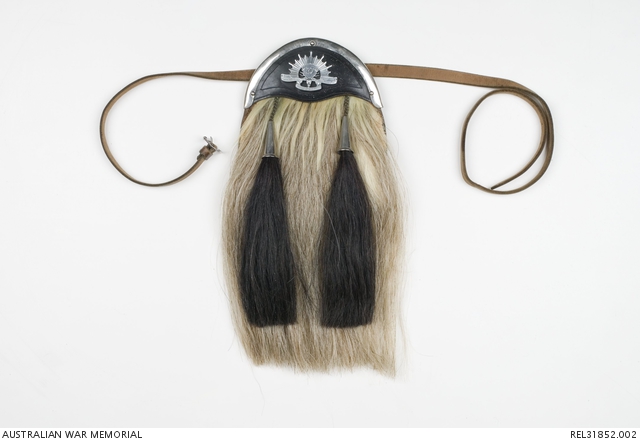| Place | Oceania: Australia, South Australia, Adelaide |
|---|---|
| Accession Number | REL31852.002 |
| Collection type | Heraldry |
| Object type | Uniform |
| Physical description | Horse hair, Leather, Nickel-plated brass, White metal |
| Maker |
Unknown |
| Place made | Australia |
| Date made | 1939-1940 |
| Conflict |
Period 1930-1939 Second World War, 1939-1945 |
Sporran : Private T V Holland, 27 Battalion South Australian Scottish Regiment

Brown leather sporran with a black leather cap at the top bound with a curved nickel plated brass edge held in place with three dome headed split pins. The centre of the cap bears a white metal badge for 27 South Australian Scottish Regiment. The brown leather front of the sporran is covered with an under layer of white goat hair and an outer layer of white horsehair. Two black horsehair tassels are suspended over the top, hanging from white metal chains and nickel plated brass caps which are attached through black painted eyelets to split rings at the back of the black leather cap. The back of the sporran, in brown leather, has an expanding pocket with a pointed flap secured by a white metal post. The lower edge of the sporran is bound with brown leather. The back of the pocket is marked in black ink 'W HOLLAND'; the same name is scratched into the leather beneath the one written in ink. Two angled black leather straps extend above the pocket and are stitched to the top of the back. A brown leather waist belt, 16 mm wide and 1280 mm long, with a nickel plated brass buckle is threaded through them.
Sporran worn by Private Thomas 'Tom' Venables Holland while he was serving with 27 Battalion, South Australian Scottish Regiment, from 1939 to 1941. Holland had previously served in the school cadet corps at Prince Alfred College in Adelaide before joining the South Australian Scottish while studying at Adelaide University. He enlisted in the RAAF on 1 March 1941, at the age of nineteen. After training he joined 233 Squadron RAF, part of Coastal Command, as a Hudson bomber pilot. Flying Officer Holland survived the war and was discharged on 29 July 1945.